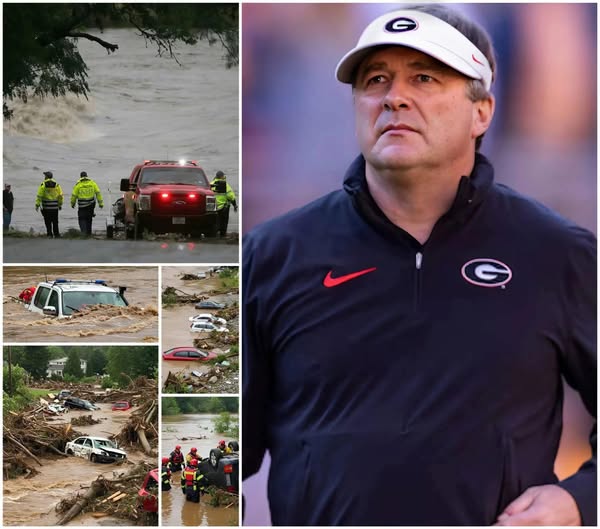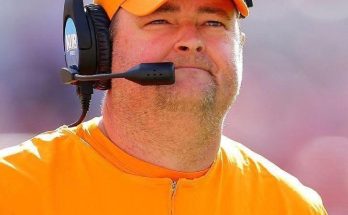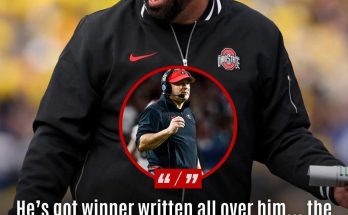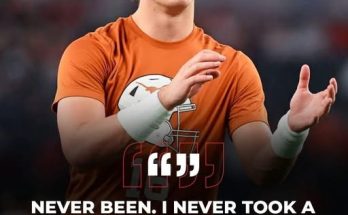The Georgia Bulldogs, long known for their dominance on the football field and their tight-knit culture, have once again proven that their power extends far beyond the gridiron. In a bold and heartfelt move that has rippled across the country, the Bulldogs have donated an astonishing $50 million to support victims and assist in search and rescue operations following the catastrophic flash floods that recently ravaged central Texas. The sheer scale of this donation sent shockwaves through the sports world, but it was the personal action of one of the team’s brightest stars that truly captivated the nation.
In the early hours following the disaster, news stations and social media platforms alike were flooded with images and videos of the unthinkable: entire neighborhoods submerged, families stranded on rooftops, highways turned to rivers, and emergency response teams battling dangerous currents to save lives. The scenes were heartbreaking, reminiscent of past natural disasters that left indelible scars on the national memory. But as the magnitude of the devastation became clear, so too did the need for urgent action.
The Bulldogs, whose athletic success has brought them not just national titles but also immense financial power, did not hesitate. In what may be the single largest sports-team donation in response to a natural disaster, they immediately committed $50 million to a coalition of relief organizations, first responders, local government agencies, and grassroots efforts. This donation is already being used to provide temporary shelter, food, clothing, medical supplies, transportation, and fuel for search-and-rescue missions, particularly in the hardest-hit rural counties where infrastructure has been entirely washed away.
What makes this story truly extraordinary, however, is the act of a single player whose name has come to symbolize not just talent, but character. Instead of issuing a generic statement or a social media post expressing sympathy, this player boarded a plane, landed in Texas, and drove directly into the disaster zone. Without fanfare or press attention, he showed up in boots, gloves, and a T-shirt bearing no school logo—just the grit of someone ready to work. Over the next several days, he was seen helping carry children through knee-deep water, distributing meals from the back of trucks, and assisting local authorities with recovery operations in areas too remote or dangerous for average volunteers.
Witnesses were at first stunned. One volunteer recalled doing a double take when she recognized him. “I thought I was hallucinating,” she said. “I mean, he’s on TV every weekend during the season. What was he doing here, lifting sandbags with the rest of us?” Another rescue worker said, “This wasn’t a PR stunt. He didn’t want pictures. In fact, when some kids asked for selfies, he kindly declined. He told them, ‘We’ll take pictures once your family’s safe and back home.’”
Though the university has not confirmed his identity publicly out of respect for his desire to remain anonymous, the story quickly spread. Within hours, fans began speculating, and soon, word got out that the player was none other than a junior defensive end projected to be a top pick in next year’s NFL Draft. Known for his explosive athleticism and commanding presence on the field, he has also been praised by coaches and teammates for his humility and sense of responsibility to others. This, according to those who know him best, was simply who he is.
His trip to Texas was reportedly made against the advice of some within the team’s management, who were concerned about safety and insurance risks. But the player was adamant. “People are out here losing their lives,” he was heard saying. “What’s the point of being strong if you don’t use that strength when it matters most?” And so he went—quietly, purposefully, and with every intention of helping, not performing.
The larger Bulldogs community, from alumni to boosters to student-athletes across all sports, rallied in support of the initiative. Fundraisers were launched in Georgia towns and cities, matching donation drives began appearing in SEC fan forums, and Bulldog fans nationwide began sending in supplies, volunteering, and raising awareness. In Athens, university officials opened campus facilities for displaced students whose families had been affected by the floods in Texas, offering free housing, meals, and counseling support.
This moment marks a powerful intersection of sports, compassion, and civic duty. While it’s not uncommon for college athletic programs to engage in charitable acts or community service, the scale and immediacy of the Bulldogs’ response set a new precedent. Their $50 million donation was not the result of weeks of planning or bureaucratic wrangling—it was immediate. As one university spokesperson noted, “This wasn’t about optics. This was about people in pain. And when people are in pain, the Georgia Bulldogs step up.”
Critics of collegiate athletics often point to the vast sums of money involved in programs like Georgia’s—multi-million dollar coaching salaries, state-of-the-art facilities, massive television contracts—and argue that more should be done to give back. In this case, those criticisms are being met with action. The Bulldogs have not only put their money where their mouth is, but they’ve also demonstrated that leadership doesn’t have to wait for someone else to act first.
In Texas, where the recovery effort is only just beginning, the Bulldogs’ impact is already being felt. Local officials have reported that several rescue missions were made possible by helicopters and watercraft funded by the Georgia donation. Shelters stocked with emergency supplies bearing Bulldog logos have opened in at least four counties. In one town, the mayor broke down in tears during a press conference, thanking the team and singling out the player who showed up “when we felt forgotten.”
The emotional toll of the disaster cannot be overstated. Dozens of lives have been lost, and many more are still unaccounted for. Thousands have been displaced, their homes destroyed or rendered uninhabitable. Recovery will take months, possibly years. But in a time of despair, hope has come in the form of unexpected allies—from another state, from a different world entirely.
National media have begun to take notice. Morning talk shows, evening news programs, and sports networks have all highlighted the Bulldogs’ efforts. One segment featured side-by-side images: on one side, the player in uniform making a game-saving tackle; on the other, him waist-deep in floodwater helping a family reach safety. The contrast is profound—and telling. It reminds us that sports figures, often idolized for what they do in games, can become even more impactful by what they do outside them.
College football fans often talk about “legacy”—what a player leaves behind, what a program stands for. The Georgia Bulldogs are building a legacy that stretches far beyond trophies and championships. They are teaching their players that greatness isn’t measured only in wins, but in the lives you touch when the lights are off and no one is watching. They are showing their fans that loyalty means showing up not just on Saturdays, but whenever someone is in need. And most of all, they are demonstrating that even in moments of national tragedy, hope can come from the most unexpected corners—from a locker room in Georgia to the flooded streets of Texas.
In the days and weeks ahead, the true scope of the Bulldogs’ impact will continue to unfold. New partnerships are already being forged between the university and Texas relief agencies. More players are expressing interest in volunteering during the offseason. And fans across the country—regardless of team colors—are being inspired to give, to help, and to care.
What began as a disaster response is quickly becoming a movement. One that reminds us of the best of college athletics. One that turns a devastating chapter in Texas into a story of solidarity. And one that proves, unequivocally, that the Georgia Bulldogs are champions in every sense of the word.



